According to the Substance Abuse and Mental Health Services Administration, nearly one in three young adults 18 to 25 have experienced a mental illness. Psychologist Mia Nosanow joins “GMA” for more.
Category: Featured
-

The Evolution of the Traditional Admissions Funnel: Adapting to a New Era
The traditional admissions funnel has long served as a trusty blueprint for ushering prospective students from initial interest to enrollment. But times, they are a-changin’. Technological leaps, shifting student expectations, and newfangled marketing strategies have all conspired to transform this once-straightforward model. So, let’s dive into how the admissions funnel has evolved and what these changes spell out for colleges and universities.
From Linear to Non-Linear Journeys
Gone are the days of the straight-line path from prospect to enrollment. The old funnel—prospect, inquiry, application, admission, acceptance, enrollment—was neat and tidy. Today, the student journey is a lot more like a hopscotch game. Prospective students zigzag through stages, start an application, go back to gathering info, and flip-flop on decisions multiple times before finally enrolling. This behavior calls for admissions teams to be nimble and ready to pivot at a moment’s notice.
The Digital Revolution
The rise of digital tech has turned the admissions process on its head. Now, online platforms, social media, and virtual tours are the main highways for students discovering and engaging with colleges. Virtual events, webinars, and interactive content are must-haves to grab the attention of today’s digital-savvy students. To keep up, institutions need to master digital marketing and create a seamless online experience.
Personalization and Data Analytics
Today’s students expect nothing less than personalized communication and experiences. With advanced data analytics, colleges can track student interactions and preferences, tailoring their outreach and engagement efforts. This means sending targeted messages, recommending specific programs, and offering personalized content that hits home with individual students. Such a personalized approach strengthens connections and boosts conversion rates.
Increased Emphasis on Early Engagement
Early engagement is now a cornerstone of the modern admissions funnel. Building relationships with prospective students well before the application stage is critical. This involves nurturing leads through meaningful interactions from as early as middle school. Colleges are investing in long-term outreach programs, summer camps, and pre-college initiatives to establish and maintain connections throughout the student journey.
Focus on the Student Experience
The student experience has become a pivotal factor in the admissions process. Prospective students are seeking more than academic offerings; they want institutions that align with their values, offer a supportive community, and provide opportunities for personal growth. Colleges need to showcase their unique campus cultures, highlight student success stories, and emphasize holistic support services to attract and retain students.
Adapting to Changing Demographics
Demographic shifts, like increasing diversity and the rise of non-traditional students, demand that colleges adapt their recruitment strategies. Institutions are developing more wide-ranging marketing campaigns and creating pathways for adult learners, transfer students, and international applicants. Understanding and addressing the unique needs of these diverse populations is crucial for staying competitive in today’s landscape.
There you have it—the modern admissions funnel is a dynamic, digital, and personalized journey. Colleges and universities that embrace these changes and adapt their strategies will be the ones that thrive in this new era.
We do NOT recruit and retain students when they understand us (the institution). We recruit and retain when students see we understand who they are.
Mondy Brewer, Ph.D., brings over 30 years of diverse experience in higher education, having held key leadership positions in admissions, marketing communications, and student success. He has also served as an Assistant Professor of Leadership in Business. In addition to his consulting work specializing in enrollment management, he currently serves as AVP – Enrollment Strategy at Liaison. Dr. Brewer holds a Doctorate in Leadership with a focus on higher education administration. His doctoral research explored the engagement of first-generation college students, offering insights into the institutional support mechanisms that promote their success.
-

Your 2025 higher education policy almanac
Well, it’s January again.
The early months of last year were dominated by the Conservatives’ slow swan dive into electoral oblivion, and then we got a general election that saw little serious discussion of the sector’s future, aside from the trotting out of a few old canards.
And since Labour took power in July, there have been two broad phases: an initial “these things take time” framing in which universities – as well as many other groups and industries – were asked to be patient. In November we got the tuition fee uplift in England (in cash terms, for one year) and news of a bigger reform plan due next summer. A little movement, but in grand terms it was still can-kicking. Even the concrete announcements we’ve had, such as on level 7 apprenticeships, have not been accompanied by detailed policy papers or formal consultations.
There’s reason to think that 2025 will have more for wonks to get their teeth into. There’s plenty pending, promised, or otherwise pretty damn urgent. So the below is an attempt to reckon with absolutely everything we know is on its way that matters for HE. Please charitably ascribe any oversights to a post-holidays sugar crash on my part rather than wilfully turning a blind eye, and let me know what I’ve missed in the comments.
Big ticket items
In Westminster politics, the first half of next year is going to be completely dominated by the spending review, which will set departmental budgets for three financial years (2026–29) as well as lay out a five-year programme of capital spending. It has always been described as being “in the spring”, but recent reports suggest that Labour will fly as close to the summer solstice as they can with this definition, so make sure you’ve got some free time in June to deal with the fallout.
If what we read in the papers is to be believed, what is – counterintuitively – the default policy of inflation-linked tuition fees will be confirmed for England at this point, taking us up over £10,000 a year by the end of the Parliament.
This is also when we’ll hear more about the government’s plans for ten-year R&D budgets. Attendees of the 2023 Labour conference may recall science secretary Peter Kyle promising a decade of confirmed funding for UKRI and ARIA – this commitment has been repeatedly qualified since then, partly due to issues of practicality (given that it’s not a ten-year spending review) and partly due to a question mark over whether fixing research spending in this way is really a good idea. It’s likely to be restricted now to “specific R&D activities” – the (much) bigger question will be around levels of investment in R&D. Plus we’ll see to what extent the government really wants to commit to linking research and its missions – last autumn brought only a small pot of cash for this in 2025–26.
Also due alongside the spending review is “further detail and plans for delivery” for the Lifelong Learning Entitlement – so don’t expect to hear much more before then, though the delayed commencement in 2027 makes the need for information marginally less pressing. And the finalised industrial strategy will also arrive, “aligned with” (and likely published together with) the spending review, laying out specific sector plans for areas like the creative industries, the life sciences, and professional services. Once complete, the idea is that these plans can then inform Skills England’s work, and potentially migration policy – it’s all very ambitious.
The HE reform announcement in England that we’ve been promised for “the summer” will land – it appears – fairly hot on the heels of the spending review settlements, and any money needed for it will need to have been allocated already, or at least tucked in to Office for Budgetary Responsibility (OBR) projections in some way. On the topic of the OBR, its spring forecast is due on 26 March – there are rumblings that its revised projections could spell fiscal trouble for the government.
There are also clear indications that the HE reform statement will be preceded, or possibly accompanied, by a review of some kind. There have been rumours of a panel in place, and the indications are that this will fly under the radar somewhat and happen quickly – think Becky Francis’ curriculum review or Lord Darzi’s NHS audit, rather than a grand commission in the traditional “major review” style we have become used to.
Around the sector
Part of the Westminster government’s reform agenda is predicated on the sector coming up with ideas itself, which may end up drawing quite a lot on Universities UK’s blueprint from back in September. UUK’s own “efficiency and transformation taskforce” will be busy putting out recommendations on business models and collaboration, with the endorsement of education secretary Bridget Phillipson – “all options are on the table,” we are told, with plenty of policy debate likely to ensue once publications begin to appear.
With many universities in poor financial shape, the search for longer-term sustainability will likely be derailed at regular intervals by news of redundancies and course closures. National industrial action is a possibility, though there are real questions around the willingness of struggling union members to take action on pay at this point. Local disputes will continue to flare up. Alongside this we have a renewed push for newer English universities to be exempted from the Teachers’ Pension Scheme due to the massively increased costs it is now carrying, a move which would substantially inflame industrial relations if it came to pass.
And looming over all of this is the possibility of a disorderly market exit, and the question of whether the government has a viable plan in place to step in if a large institution were to hit the wall. All the other policy developments we are highlighting here could be hugely complicated by a sudden shock to the system and what is likely to be a political rather than a strategic response.
The world of regulation
There’s a lot to look out for from the Office for Students, from the appointment of a new permanent chair down (interviews are being held this month).
There’s the ongoing consultation on a new strategy, the continuing fallout from the temporary closure of the register (this should supposedly also bring new proposals on improvements to the registration process), whispers of a more “integrated approach” to quality and whatever that means for the TEF, and a greater regional focus to access and participation.
We should start getting assessment reports for the second round of quality investigations (where franchising and foundation years will be a focus) as well as the belated release of those grade inflation investigations that were announced on 2 September 2022. We’re waiting for consultation responses on a new approach to public grant funding and even on LLE regulation, though you can’t blame them for waiting to see what exactly the government is planning with this one.
According to last summer’s business plan, there should also be consultations of potential new initial conditions of registration on both management and governance, and consumer protection. And this year’s National Student Survey will have a sexual misconduct questionnaire appended – though it’s not clear at time of writing to what extent the results will be made public.
Over in Wales, Medr is taking shape, with a finalised strategic plan due to have been submitted to the Welsh government for approval just before the Christmas break – we should hear more of this soon, along with the consultation response.
And if all that sounds like a lot, in Scotland we are due a Post-School Education Reform Bill at some point in the 2024–25 parliamentary session, which will make big changes to how the Scottish Funding Council (SFC) and Student Awards Agency Scotland operate. A consultation which closed in September asked stakeholders for thoughts on what the funding agency landscape should look like – we haven’t heard much since then. The sector is keen to stress the importance of universities retaining their autonomy, whatever happens – legislative passage could see MSPs push for new duties on the SFC.
We’ve been aware for a long time that the Office for National Statistics is undertaking a review into whether higher education should be seen as “public sector” in the national accounts – it’s now been slightly rejigged into a review of the statistical classification of “the transactions in which UK universities engage.” For what is a very technical definition, an eye over the recent travails of the FE sector suggest that there are potential implications for everything from procurement to senior staff pay. The long delayed work will kick off early in 2025.
The research agenda
What little research policy we’ve seen come out of the new government so far has been limited to haggling over budgets and science minister Patrick Vallance stressing that ministers should not meddle in university research. There’s no reason to think we will get big policy pronouncements out of the Department for Science, Innovation and Technology, which feels more interested in the tech and digital side of its remit, both legislatively and aesthetically. But there’s lots going on around the margins that could end up being quite consequential.
First up we have the appointment of a new UKRI chief executive, where there’s already evidence the new minister has been having a think about longer term strategic direction. While the new roleholder won’t take up office until June, we should get news of the appointment fairly soon.
In the Research Excellence Framework world, the “modular” approach to releasing different policies on a staggered timetable will see the release of the volume measure policy (imminently) and the contribution to knowledge and understanding policy (scheduled for the summer). The more contentious people, culture and environment pilot will continue throughout the year, with criteria and definitions due for the winter – any slippage on this will likely provoke controversy.
At UKRI, January will bring an update on its work reviewing how PGR stipends are set (as well as the stipend level for 2025–26). Elsewhere, the ongoing National Audit Office work looking at UKRI grants and loans could be a wildcard – it’s due to report in spring 2025 – and at the very least is a moment where the government will need to comment on how the research funding system is operating. Research England is also thinking about the current state of research infrastructure, via its condition of the estate survey, and how the sector’s financial challenges are affecting research – for both of these pieces of ongoing work, it’s doubtful that much will be shared publicly.
Further afield, a European Commission proposal for the successor to Horizon Europe is due midway through the year, preceded by an interim evaluation of the current funding programme which will likely give an indication of its plans. We will also get regulations for the Foreign Influence Registration Scheme in the new year – the measures, which will speak to research security, are now expected to come into effect in the summer. It’s been reported that the government is resisting calls to put China on the “enhanced tier” of the scheme, a move that would have greatly complicated UK-China academic partnerships. On a related note, the government has quietly been conducting a “China audit” – this will be released in the coming months, and in theory will spell out the policy areas where closer ties will be permitted.
Finally, the House of Commons Science, Innovation and Technology Committee will be conducting a timely inquiry into regional R&D, which should be a good opportunity for some more insight into how the government’s English devolution-related plans for more mayoral involvement in the research system will come together.
International
If you had to pick a policy area that will have the biggest macro impacts on the sector in 2025, you could do a lot worse than opt for international recruitment (you would arguably have been proved right if you’d chosen it in any of the last few years).
Two big policy items are on their way here: a legal migration white paper, spelling out how the government will fulfil its electoral promise to bring net migration down. And a revised international education strategy (IES), which we’re told is coming “early spring” – whether it will appear before, after, or alongside the white paper remains to be seen, but could be significant.
The big questions here are whether the government will put a recruitment target on the face of the strategy – the aspiration for 600,000 students in the last one ended up coming back to haunt the Conservatives among their own base – and what the plan for education exports targets might be. But there are other areas we could see movement, such as on post-study work, where some in the sector seem hopeful that a little improvement could be on offer, despite the enormous political pushback the Graduate route has faced over the last couple of years. It feels like an outside bet.
More important to keep an eye on will be whether some kind of arrangement is arrived at with net migration statistics – we know that the Office for National Statistics is looking at how estimates excluding students could be arrived at, and it’s been on the higher education sector’s wishlist for years.
If it did come to pass, the devil would very much be in the detail – the Migration Advisory Committee annual report has already been noting the contribution that students make to long-term net migration, and Starmerite think tank Labour Together’s recent proposal is for visa routes such as Skilled Worker and Graduate to have multi-year targets, even if the Student visa does not. Put like that, it sounds like a recipe for universities to recruit pretty freely but for students’ post-study options to remain a political football – the seeming lack of student involvement in the IES review would appear all the more glaring in this case. The Universities UK blueprint did promise a kind of quid pro quo on responsible international recruitment, and it has been notable that government ministers have stressed the importance of housing availability when the question has come up in Parliament recently.
Whatever comes out of it, it looks clear that the Home Office will continue to toe a careful line on student visas, and continue to implement the last government’s Graduate route review response. The use of “action plans” by UKVI for certain providers will continue, even if there is no substantive public comment from the Home Office about what these are and why they are being imposed. And there will also be a review of English language self-assessment policies over the next few months, “driven by growing concern around underlying reasons for reports of students being picked up at the border or entering UKHE with low levels of English” (in UUKi’s words). It’s unlikely much will be shared publicly about these, but they are items to watch, especially in the event that there is further negative publicity about international students in the media.
It’s worth stressing that developments in migration and visa policy do not only affect students – the House of Lords Science and Technology Committee is next week highlighting the interplay between visas and international researchers, and there are ongoing issues such as the future of the family visa income threshold where the government will eventually need to take a position.
And despite all this policy in play, the three most significant factors for future international recruitment with likely be the Australian federal election – where the incumbent government’s attempts to impose number caps have been thwarted by an opposition that wants bigger caps – the Canadian election – which could happen at any minute if Justin Trudeau is forced out, and where the Conservatives are strongly favoured to take power – and the impact of Donald Trump on the USA, where universities are already reportedly asking international students to return before he takes office. All these things have the potential to greatly benefit the UK “market”.
Skills, skills, skills
Before we get any HE reform news out of Westminster, there’s going to be policy elsewhere in the post-compulsory system, with Skills England gearing up for action – we’ll learn the appointments of chief executive and permanent chair pretty soon – and various policy pronouncements at this end of the tertiary sector are overdue.
Probably the most impactful for higher education is confirmation about exactly what is happening with the apprenticeship levy, both in wider terms of the planned additional flexibility for non-apprentice courses (this will be less than the 50 per cent originally proposed… at least probably), and for the “defunding” of level 7 apprenticeships.
Many universities are big operators in this space, and it appears that most if not all of these programmes will be removed from the levy’s scope (“a significant number” is the most recent framing from the government). Over Christmas the Telegraph reported that the much-feted doctor apprenticeship is now “paused in perpetuity”. We should get the full picture very soon, as well as the much-awaited post-16 strategy, which you would hope would give a decent insight into the government’s wider vision for tertiary education. Though it may not.
The defunding of level 7 apprenticeships is also relevant for those higher education institutions that have been spending their levy contributions on such courses for their staff as part of their professional development offer. DfE assures us all that employers are more than welcome to pay for them using different funds, “where they feel they provide a good return on their investment.”
Our world in data
We’re getting the outcome of the Data Futures review soon! There may be some lessons to learn about programme management and platform delivery, which could play out as a shared commitment to improving processes or as an unedifying multi-agency row. Whatever the case, this year’s HESA Student data will arrive later than usual – “in the spring, earlier than last year’s August publication but later than the January release date achieved in previous years.” Whether this is spring as in daffodils, or spring as in spending review, remains to be seen – but the delay (and issues with data quality as we saw last year) will have a knock on effect on data releases elsewhere, once again.
At the end of this month we are getting HESA Staff data for 2023–24. The headline figures from last year’s release did get quoted the odd time by the previous government – in answer to questions about the impact of redundancies and cuts, it would occasionally be pointed out by ministers that (academic) staff numbers were still rising when you look at the sector as a whole. These figures won’t show the impact of this academic year’s cuts, however.
Of course, elsewhere we have the usual releases which make up the HE wonk’s annual working rhythm. UCAS end-of-cycle numbers, at provider level, are due out at the end of January, and further down the line (probably around spending review time!) we have HESA Finance data and the Office for Students’ accompanying financial sustainability report, which will likely once again be a moment of maximum attention for higher education’s bottom line.
One other piece of data we are getting this spring is a new ONS release on student suicides. This will come alongside the independent review commissioned by the last government, and whatever the findings is likely to generate a lot of press coverage and renewed pushes from campaign groups and opposition parties for a statutory duty of care. Early indications from the current government is that they are happy with the voluntary, sector-led approach to mental health – but things can change.
Elsewhere in government
It’s amazing it’s taken us this long to get to it, but probably the biggest, most controversial item on DfE’s to-do list is a decision on the fate of the free speech act and its associated provisions and complaints scheme. The Free Speech Union has its day in court on 23 January as part of a legal challenge over the pausing of the bill’s commencement – it’s just possible that the government will try to get a decision out before then. Or it could all drag on intractably for several more months, very much in keeping with the legislation’s passage through Parliament.
Another hugely consequential move which we may see from DfE this month is the launch of a consultation on proposals to “strengthen oversight of partnership delivery in higher education” in conjunction with OfS. The department “will be developing options for legislative change, if required,” the Public Accounts Committee was told back in September, with a target date of January 2025 for an update.
We’re due impact assessments and regulations for the tuition fee and maintenance “increases”, which should also involve a government pronouncement on how much the national insurance increase will cost the sector. And while it’s not higher education business, the soon-to-appear curriculum review (covering the curriculum in England from key stage 1 to key stage 5) will have long-term consequences for the wider education system – as well as likely sparking further backlash among those worried about it recklessly promoting diversity and risking PISA scores.
Elsewhere in Westminster, the ongoing parliamentary passage of massive pieces of legislation will have big consequences for universities and students. The Employment Rights Bill and the Renters’ Rights Bill will both likely see some amendments, and we’re still awaiting the text of the English Devolution Bill and the promised “Hillsborough” bill. The government’s NHS plan for change – again, due at some point in the spring – and proposed updates to the NHS Long-Term Workforce Plan are important to keep an eye on as well.
Up in Scotland, one day we may see the fruits of the ongoing review of student maintenance for part-time students. Negotiations over the 2025–26 budget will dominate the parliamentary agenda in the early part of the year, with ministers appearing in front of committees to get into the details of what exactly will be funded and what will not – and then the countdown to 2026 elections begins (all of this sentence is also true in Wales).
It’s dangerous to go alone – take this
If you’ve made it this far, congratulations. It feels like there is currently a huge number of moving parts in play in policy-land, all of which will contribute to the future shape and operations of the UK higher education sector in various, often hard-to-predict ways. Some are pretty immediate, others are issues that should have been tackled long ago, and then there are long-term policy changes that will be massive news in the 2030s.
Here at Wonkhe we try to cover every single policy development that affects the sector, especially in our Daily Briefings (which restart on Tuesday 7 January – my alarm is already set).
So if you’re interested in following even a fraction of the stuff that’s set out above, do join us for the ride this year. And fair warning, it’s likely that a good number of the most important developments that 2025 has in store for us are not even on this list. We’ll cover those as well, the moment they arrive.
-

Challenging climate hypocrisy in higher education learning and teaching
By Dr Adrian Gonzalez (@AGonzalez05) Senior Lecturer in Sustainability and Director of Learning and Teaching, Department of Environment and Geography at the University of York.
Climate hypocrisy in Higher Education
The climate crisis and global attempts at strengthening the sustainable and low-carbon transition is arguably the most critical issue we face and there is clear evidence to show strong Higher Education (HE) support for this twin approach. However, HE, particularly in the Global North, faces increasing scrutiny and critique over its implementation of the sustainability agenda. This has led to accusations of greenwashing, in which universities (willingly or perhaps erroneously) overmarket and/or underdeliver their sustainability policies, and climate hypocrisy, where an internationalist agenda frames student recruitment (the drive towards overseas markets), research activities and partnerships. For example, in UK tertiary education (further education and higher education), the largest sources of travel emissions are student flights, but there has been limited focus on the emissions stemming from learning and teaching, particularly fieldtrips, which this post is keen to reflect on.
Destination long haul; Higher Education residential undergraduate student fieldtrips
Outdoor education, particularly fieldtrips, offer a wide array of learner benefits and can be integral to different undergraduate programmes such as Geography, Earth and Environmental Sciences (GEES), archaeology, history and classics. However, the competitive UK higher education market has helped generate an internationalisation of undergraduate fieldtrips which are now used as a critical marketing tool to attract prospective students, who as ‘consumers’, are increasingly keen on knowing where these trips go to inform applications. For example, a brief internet search of UK GEES departments shows undergraduate trips heading to exotic locations such as the Amazonia region, Colombia (BSc Environmental Science), Bahamas (BSc Ocean Science and Marine Conservation) and Malawi (BA Human Geography).
Climate hypocrisy is evident here; students are studying programmes that acknowledge and grapple with the climate crisis and the need for transformational structural changes, yet at the same time will be enrolled on degrees that facilitate long-haul international learning opportunities without significant acknowledgement or reflection of the environmental impacts. Whilst there is no reliable publicly available data on the level of carbon emissions generated by GEES and other subject fieldtrips in UK higher education, I can give an indication by drawing on a case study of the department I work in.
Department of Environment and Geography, University of York
The department runs a wide variety of one-day and residential fieldtrips across its undergraduate and postgraduate programmes. It is the undergraduate residential trips that, owing to their design, have particularly significant carbon emissions and were made the focus of the subsequent investigation. Until 2022-2023, the department ran several residential fieldtrips that encompassed both UK and overseas destinations for its four undergraduate programmes (BSc Environmental Science; BSc Physical Geography and Environment; BSc Environment, Economics and Ecology; BA Human Geography and Environment).
I used the University of York’s carbon calculator, which draws upon the UK government’s Department for Environment, Food and Rural Affairs greenhouse conversion factors to calculate the carbon emissions stemming from travel and accommodation and the offsetting requirements. The table below shows the residential fieldtrips and carbon emissions from travel (including coach and flights where relevant) and accommodation on a per-person and 50-person basis. For four 50-person trips, this generated 108,521.85 kg CO2e (or 109 metric tonnes rounded up), equating to a carbon offsetting cost of £3,437.97 for the Department on an annual basis.
Table 1: Department of Environment and Geography, University of York fieldtrips up to 2022-2023
What does this total figure equate to? A good comparison is the Stockholm Environment Institute (SEI), an international non-profit that focuses on environment and development challenges and employs 170 staff working across several international regional centres. At the time of these fieldtrips operating, SEI’s 2020 annual report indicated that its air travel emissions were almost 550 metric tonnes CO2e (in 2019). So these department fieldtrips made up the equivalent of almost 20% of the total air travel emissions of a major international research organisation.
Conclusion: a call to action
These figures indicate the scale of the socio-environmental impacts caused and the urgent need for UK higher education learning and teaching operations, particularly in GEES given the subject areas, to be seen as ‘walking the talk.’ There have been recent efforts to address this issue through the work of the RGS-IBG who have developed a list of voluntary principles to guide geography fieldwork, including the adoption of ‘sustainable fieldtrips’ which acknowledge the need to recognise and justify the resulting carbon impacts. Whilst it is positive to see 31 institutions signed up, this is less than half of the UK GEES departments and does not incorporate any wider disciplinary commitments.
This article raises a call to action for all learned institutions and UK HE departments operating residential fieldtrips to adopt sustainable fieldtrip principles and operations. Without system-wide change, climate hypocrisy remains unchallenged in UK higher education learning and teaching.
To support academic staff and departments, several steps towards sustainable fieldtrips can be taken:
- Conduct a carbon audit of fieldtrips to ascertain the impacts as undertaken at the Department of Environment of Environment and Geography, University of York;
- Using this data, consider revising long-haul fieldtrip locations to relevant localised destinations that can be reached through low carbon (i.e. no flights) transport;
- Publish the carbon costs on the department or university website to support wider debate and discussion of sustainable fieldtrips;
- Implementing sustainable fieldtrips can lead to multiple Equity, Diversity and Inclusion (EDI) benefits, particularly around accessibility and inclusivity. Use this opportunity to review and seek to strengthen the EDI agenda.
- Disseminate best practice guidance through research and conference outputs;
- Lobby learned institutions to adopt sustainable fieldtrip principles that align with those adopted by the RGS-IBG;
Through these steps, UK higher education can begin to create a more holistic, robust and transparent sustainability and decarbonisation agenda.
However, these actions cannot happen in isolation or nullify wider critical discussions around the UK HE sustainability agenda. One of the most significant discussion points is the impact of international students studying in the UK, a country which is the second most popular study destination in the world. Whilst these students provide significant economic benefits to the UK economy (£41.9 billion between 2021/22) and are vital to the UK higher education business model (one in six universities get over a third of their total income from overseas students), the carbon footprint far surpasses the UK higher education fieldtrip contribution. A 2023 report from 21 UK further education and higher education providers concluded that student flights accounted for 2.2 metric tonnes of CO2e or 12% of total emissions, whilst globally, student mobility is estimated to generate at least 14 megatones of Co2e per year (14 million metric tonnes). It is clear therefore that in the UK context, there is an urgent need for a robust policy debate on UK higher education funding and student mobility, otherwise the sector’s decarbonisation agenda will remain only partially addressed through sustainable fieldtrips.
-
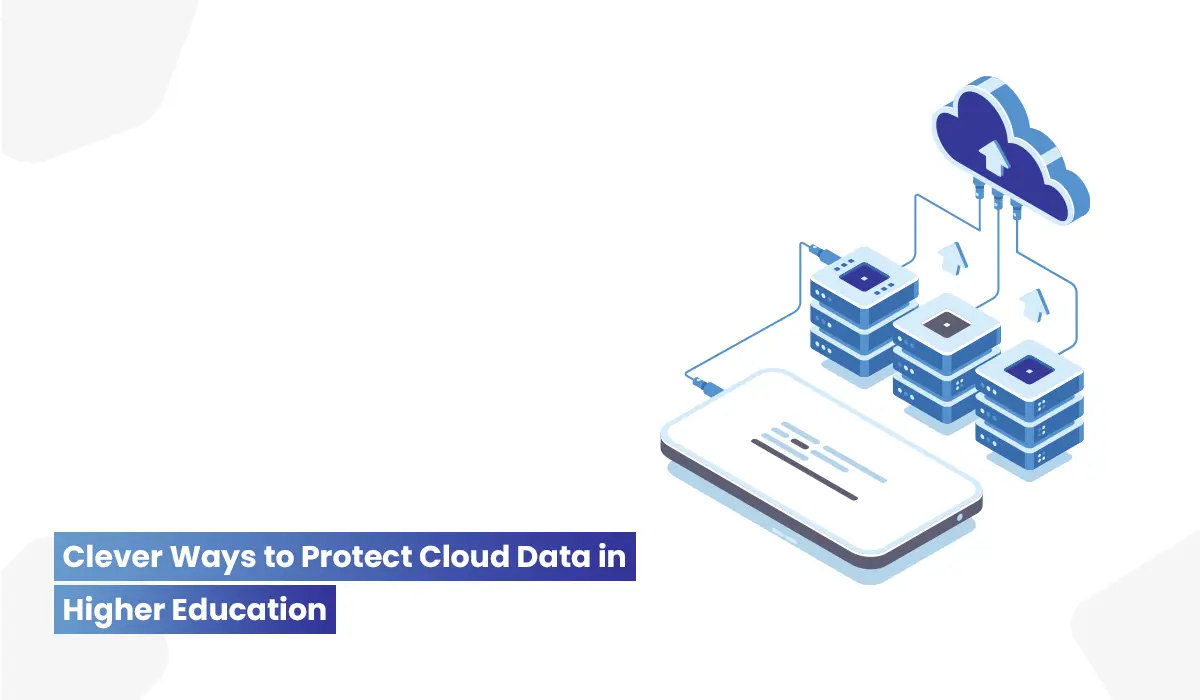
Top 5 Strategies to Enhance Cloud Security in Higher Education
The transition to cloud computing has revolutionized higher education by enabling enhanced collaboration, scalability, and flexibility. On the other hand, the cloud’s ability to improve data security is a substantial advantage that is often overlooked. Securing a cloud environment necessitates a proactive approach, rather than solely implementing cloud-based technologies. Here We have collated the top are five strategies to optimize cloud security in higher education:
Cloud security in higher education: Importance of data protection for HEIs
Higher education institutions have a great deal of sensitive student and institutional data to handle, hence data security and cloud security in higher education is a top issue. Safeguarding sensitive data depends on strong adherence to laws including FERPA and GDPR, therefore guaranteeing ethical usage, limited access, and safe storage. According to surveys, giving transparency and strong data protection a top priority and opting for solutions to protecting student data in the cloud not only helps to prevent breaches but also fosters staff and student confidence, hence improving engagement and institutional reputation.
5 Clever Strategies for Secure Cloud Adoption in Universities
1. Emphasize control rather than location
The belief that on-premises data storage is intrinsically more secure may be deceptive. Although server rooms appear concrete, they remain susceptible to breaches, natural calamities, and maintenance issues. Cloud solutions offer superior security features, like powerful firewalls, automatic backups across many sites, and multi-site processing to reduce risks and enhance recovery efficiency. Institutions may be confident that their data is secured by superior infrastructure.
2. Adopt the paradigm of shared responsibility.
Cloud security is not the responsibility of a single individual; it requires collaboration. The vendor is able to manage hardware maintenance, patching, and enhancements in physical infrastructure security by collaborating with a reliable cloud provider. This enables your internal IT staff to concentrate on strategic data governance, institutional policies, and user access control. By coordinating activities, academic institutions can enhance their security and facilitate more effective departmental decision-making.
3. Employ sophisticated security features
Cloud platforms offer a diverse array of integrated security features, including identity management systems, multifactor authentication (MFA), and advanced encryption. These features guarantee that only authorized individuals can access sensitive information. Moreover, cloud providers consistently enhance their security protocols to address emerging attacks, enabling your organization to remain proactive against potential hazards.
4. Make scaling easier without putting security at risk
Higher education needs are changing quickly, and old IT systems often can’t keep up. But the cloud lets you grow without sacrificing protection. Institutions can increase or decrease storage space, processing power, and entry controls without affecting the security of academic institutions and their data. For instance, access can be tailored to each role, so administrators, faculty, and students will only see data that is important to them.
5. Invite everyone to be conscious of cloud security in higher education
Usually, people are the weakest component in data security. As you migrate to the cloud, for instance, teach your employees and children about best practices include using secure passwords, turning on multifactor authentication, and identifying phishing efforts. Successful usage of the security features of the cloud reduces user error-related risks by means of informed communities.
Cloud technology in campus management – Creatrix Campus higher education cloud suite
The move to cloud technology in higher education is more than just a trend; it’s a huge chance to make data safer. Despite early concerns, institutions that follow these criteria can fully utilize the cloud’s data protection capabilities.
Higher education institutions can adapt to this new reality with Creatrix Campus’s robust, secure cloud-based technologies. Can you commit to data security? Secure cloud solutions for academic institutions may help your institution.Get in touch for details.
-

How to Recruit Undergraduate Students Who Persist
Key Takeaways:
- Today’s undergraduate enrollment and recruitment strategies should be data informed and personalized, prioritizing quality over quantity.
- “Flipping the funnel” shifts the focus from mass marketing to building meaningful, tailored connections with students, ensuring better matches and higher retention rates.
- Student personas and data analytics enable institutions to craft targeted messaging that resonates with individual student goals.
- Liaison’s tools empower colleges to use predictive analytics, real-time engagement, and tailored outreach to attract and retain students who are well-suited to their programs.
For today’s higher education institutions, attracting the right students is more important than reaching a high volume of applicants. Traditional enrollment models that rely on casting a wide net and filtering through broad pools of applicants are no longer enough. Colleges and universities must instead adopt data-informed, personalized strategies that focus on quality over quantity.
Liaison’s suite of advanced tools makes this possible, offering data-focused insights, real-time engagement capabilities, and tailored outreach options. This approach not only streamlines recruitment but also ensures a stronger match between students and their chosen programs, leading to higher yield and retention rates and ultimately providing a more fulfilling educational journey.
Flipping the Funnel: Moving From Volume to Value
Historically, institutions have used a “funnel” approach to undergraduate admissions and recruitment, beginning with a large pool of prospective students and narrowing the field. But with today’s intensified competition, this model is proving less effective. Rather than expanding the top of the funnel by acquiring more student names, “flipping the funnel” is a strategic approach that begins with the end goal in mind: enrolling and retaining the students who will thrive at your institution.
Flipping the funnel shifts the focus from raw numbers to meaningful connections. Instead of mass marketing, this approach encourages institutions to recruit based on the distinct needs, goals, and interests of each student cohort. Just as each program or field has unique strengths, each student brings unique aspirations and potential. This customized outreach means that a prospective engineering student, for instance, might receive information about hands-on lab opportunities, while a fine arts student sees highlights of campus studios and faculty profiles. Liaison’s Enrollment Marketing and CRM solutions facilitate this tailored approach, allowing schools to reach specific audiences on digital platforms with messages that resonate with individual student interests.
Building Student Personas to Enhance Targeting
Understanding how to recruit undergraduate studentswho are likely to succeed and remain engaged throughout their academic journey requires a clear understanding of those students. Creating detailed student personas—representations of ideal applicants based on real data—lets institutions tailor their outreach with pinpoint accuracy. For example, Liaison’s CRM solutions facilitate this process by analyzing key data points such as academic background, geographic location, and behavioral insights, helping teams identify the students most likely to flourish and stay enrolled.
With clear student personas in mind, institutions can deliver customized messaging that aligns with students’ priorities. For example, a prospective first-generation student may be most interested in affordability and support services, while a STEM-oriented applicant might respond better to information about research facilities and career pathways. Crafting communications based on these personas enhances engagement and strengthens student bonds from the beginning. By sending recruitment messages that truly speak to students’ goals, institutions foster a sense of belonging, which in turn improves retention and satisfaction rates.
Utilizing Data Analytics for Personalized Interactions
Data analytics has become an essential tool for individualizing outreach to connect with the right students with the right message at the right time. Real-time data enables institutions to track student responses, identify prospective students’ preferences, and adapt strategies based on what works best. Liaison’s AI solutions are designed for this agile approach, allowing institutions to monitor interactions and adjust their recruitment efforts dynamically throughout the enrollment cycle.
With predictive and prescriptive analytics, schools can employ advanced tactics like retargeting, which reconnects with students who may have previously shown interest but haven’t yet committed. By capturing students’ attention during “micro-moments” as they browse social media or search online, institutions can stay relevant and timely in their communications. This data-informed approach—using Liaison’s Enrollment Marketing and digital services—increases enrollment numbers and forms trust with students by providing content that aligns with their journeys. The result? Stronger engagement and a greater likelihood of success.
Transforming Enrollment With Data-Informed Precision
In higher education, student recruitment requires a thoughtful, data-centered approach that emphasizes quality over quantity and personalization over generalization. By leveraging tools like Liaison’s Enrollment Marketing, TargetX, Outcomes, Search, and Othot, institutions can move beyond traditional methods and create recruitment strategies that attract students who are well-suited to their programs. By creating tailored recruitment strategies aligned to student cohort needs, you inspire students with a stronger sense of belonging and deeper engagement throughout the enrollment cycle. That, in turn, drives long-term success on your campus.
To discover how Liaison’s technology solutions can transform your recruitment practices, reach out to us today. Our team is ready to help you implement data-backed, individualized outreach strategies that benefit your institution and future students alike. Contact us for a demo or a consultation to see how Liaison’s tools can elevate your enrollment efforts!
About the Author
Craig Cornell is the Vice President for Enrollment Strategy at Liaison. In that capacity, he oversees a team of enrollment strategists and brings best practices, consultation, and data trends to campuses across the country in all things enrollment management. Craig also serves as the dedicated resource to NASH (National Association of Higher Education Systems) and works closely with the higher education system that Liaison supports. Before joining Liaison in 2023, Craig served for over 30 years in multiple higher education executive enrollment management positions. During his tenure, the campuses he served often received national recognition for enrollment growth, effective financial aid leveraging, marketing enhancements, and innovative enrollment strategies.
-

Looking back at HEPI’s most controversial reports – including an unexpected one from 2024
HEPI Director, Nick Hillman, starts 2025 by looking back at some HEPI controversies from the last decade.
New Year’s Day marked the first day of my twelfth year at HEPI. Over that time, I’ve had a hand in publishing (and writing) over 200 reports. None has stoked controversy for the sake of it, but neither have we shied away from publishing things that people feel need to be said even if they might be deemed by some to be controversial.
Fortunately, just four (that’s under 2%) of these pieces have flared into major rows. That’s about one report every three years or so on average, which doesn’t feel too bad a record for think-tank land. If we were in the business of stoking controversy for the sake of it, then it would be fair to say we are not very good at it.
Most people understand the role of think tanks is to make people think, whether they agree with them or not. Indeed, HEPI was founded as an offshoot of HEFCE in the early 2000s because it was felt there were things that should be said but which an official arms-length body could not easily say, with the overarching goal of speeding up the policymaking process
Some reports we were initially a little nervous about putting out have been accepted at face value without getting anyone too hot under the collar. (A recent one of this ilk looked at the experience of trans and non-binary students.) But more intriguingly, those HEPI reports that have been deemed controversial have not generally been the ones I thought in advance would be.
And each one is now seared on my mind.
A UKIP Licence
The first of these, published back in 2015, proposed a National Licence to give everyone with a UK Internet Protocol address access at no upfront charge to past and present academic research. The associated backend costs were designed to be covered by government payments to publishers.
FE lecturers and some health professionals welcomed the idea wholeheartedly, as they tended to think better access to the latest and past research would help them do their jobs. However, the more headbanger-ish element of the open-access world thought it outrageous that free access might be limited, at least initially, only to those in the UK. They also disliked the fact that publishers would continue to receive material payments.
As you would have needed a UK IP address to benefit from the National Licence and as the UK Independence Party was then riding high, the critics amusingly caricatured the paper as a ‘UKIP’ idea. Less amusingly, one academic called for it to be withdrawn, only to rescind this when it was suggested that this might be illiberal – before changing his mind once more and calling again for a ban.
The paper is still available but the National Licence idea has not made any progress and the major challenge of poor access to academic output for those without institutional log-ins (including policymakers, not to mention think-tank staff…) remains.
Boys to Men
The second controversial piece – produced in 2016 – was on the education of boys, who fall far behind girls in our education system. This, sadly, also remains a big problem that no government has gripped (though it’s not too late for the current Government to do so). Our paper was condemned, for example by the then leadership of the National Union of Students (NUS), for emphasising sex rather than class.
At the time, I said the report seemed to have been treated like an embarrassing relative who sits in the corner at family gatherings spouting politically incorrect nonsense.
In response to such condemnation, we pointed out that it is possible to be worried about more than one issue at a time and that, as disadvantaged girls tend to do a little better than disadvantaged boys, sex seems one important factor to consider alongside all the others when assessing outcomes.
The challenges in this area are perhaps a little better understood these days than they were a few years ago – thanks to excellent work from people like Richard Reeves, a Brit who is now the President of the American Institute for Boys and Men and who has written an whole book on the topic and who recently spoke at a really good Bright Blue event on the issue). So when we return to the topic, as we would like to do early in 2025, perhaps it will be less fraught.
Grammar schools for all
The third row was predictable. It occurred six years ago, on the back of a HEPI piece by the right-of-centre policy wonk Iain Mansfield. He defended grammar schools and their impressive record in getting BAME (Black, Asian and Minority Ethnic) pupils into the most selective universities, such as the University of Cambridge.
This paper (like the one on the National Licence) appeared in HEPI’s Debate Paper series, which is more polemical in its approach than HEPI’s other papers, for we knew it might stoke a row. Yet after publication of Iain’s paper, which had gone through our regular peer-review process as with all full-length HEPI papers, one well-respected expert in the sociology of education working at a Russell Group university declared HEPI should ‘disband’.
However, most of the opposition to Iain’s paper was classier. Unlike other – more ideological – think tanks, we invariably encourage people who disagree with something we have published to write for us too. So we encouraged the critics to gather together under two Oxford academics to produce a strong HEPI paper of their own that responded to Iain’s work in the form of a series of essays.
In their respective pieces, Iain and his critics were largely focusing on different issues – Iain looked mainly at access to selective higher education on leaving grammar school and the collection of essays concentrated mainly on how grammar school systems tend to work against the interests of those who are shut out from them. While the debate was angry in parts, it was properly evidence based and therefore very illuminating.
As someone who lives in part of the country where nearly all children still take the 11+, I found the discussion usefully educational and took something from both sides. Iain as the initial protagonist and someone who thrives on intellectual debate certainly welcomed it.
Helping postgraduate parents
The row in 2024, in contrast, came as a complete surprise. It was prompted by a HEPI Policy Note on the lack of childcare support for parents who are early career researchers.
The paper, written for HEPI by the GW4 group of universities in England and Wales, was based on the personal testimonies of postgraduate parents. It argued that postgraduate parents should become entitled to the same support that is available to undergraduate parents:
the current approach does not provide the right incentives to support social mobility through education. Extending the current undergraduate Childcare Grant to postgraduate students would seem a logical first step to support the most economically disadvantaged.
The paper also explained that the authors knew their proposals would not solve all the problems faced by postgraduate parents:
While GW4 acknowledges that this would not be a panacea for all postgraduates, extending the support to those with the greatest need would be a welcome first step to ensure parity of policy.
So the authors also floated going further:
A future step such as expanding the 30 free hours, so that childcare does not continue to be a barrier to the reskilling and career progression opportunities that postgraduate studies can provide, is worthy of consideration if the ambitions of the R&D People and Culture Strategy are to be delivered.
This seemed a relatively uncontroversial conclusion, not least because it was in tune with HEPI’s earlier uncontested work pointing out how postgraduate researchers often fall through the gap between student support and employee benefits. Moreover, all our other work on improving the lives of early career researchers had been widely welcomed; in 2024 alone, this included a collection of essays with the British Academy and a study of the career progression of Black early-career academics with the Society of Black Academics and GatenbySanderson.
So we assumed that, if only we could secure engagement with its contents, then the HEPI / GW4 Policy Note calling for modest improvements in the support for postgraduate parents in England would also land on fertile soil. Yet the outcry from a small number of those who read it and who thought it did not go far enough was extraordinary.
Playing the ball not the person
The process for putting a paper of this sort together takes months and, during this time, we had lots of fascinating conversations about whether the proposals should be bolder, whether or not we should argue that England should simply and immediately copy the generous arrangements in Wales (even though Wales is better funded thanks to the Barnett formula) and which arm of the state should have responsibility for childcare support for postgraduates. The wording about better short-term arrangements only being a ‘first step’ reflected these discussions.
Although the Policy Note was not my work, I used my social media channels to help publicise it and so drew much of the ire from academics on X / Twitter. Initially, I was asked why we wanted to block people from ‘feeding our families’. Later, and after I had pointed out this criticism seemed not to be based on a close reading of the actual paper, I was called ‘unhinged’ and accused of ‘misogyny’ and ‘everyday sexism’. One message about the report was tagged with ‘VAWG’, which I learnt stands for ‘violence against women and girls’. Remember, our paper proposed introducing – not restricting or abolishing – childcare support for postgraduate parents, and with a focus (initially) on the poorest ones most in need.
Anyone serious about helping postgraduates should surely avoid the sort of attack that only serves to deter people from becoming involved in policymaking in the first place. At HEPI, we will always have the back of anyone who writes for us (irrespective of whether individual members of HEPI staff personally agree with them or not), but people are still bound to be put off if they find their peers prefer to play the person not the ball the minute they arrive on the pitch.
Put simply, not everyone is able to respond to attacks in the wonderful way that the Cambridge academic Dr Ally Louks has been doing so effectively in recent weeks. Perhaps we could all learn something useful from her.
Policymaking is hard…
Successful policymaking is hard. It relies on lots of people putting their heads above the parapet to light a better way. HEPI wants to encourage debate across the whole range of higher education policy issues, but that needs a conducive environment in which to flourish. If we really are serious about producing a better environment for postgraduate students – and as our work consistently shows, HEPI certainly is – then we need a constant stream of new ideas, persuasive papers and open debate.
At HEPI, we remain committed to encouraging a positive environment and, as a think tank publishing 35+ reports a year plus a daily blog, we rely on sourcing lots of good content, ideally from those at the coalface – and irrespective of whether they have written for policymakers before.
So just as we have encouraged those who want to go further than we proposed in the GW4 / HEPI report on postgraduate parents to write an alternative piece for us (currently without success), we also encourage others to make it their New Year’s Resolution to write for HEPI. If you are even mildly tempted, our Instructions for Bloggers can be found here and our Instructions for Authors are here.
-

Dartmouth Men’s Basketball Team Drops Union Bid
The Dartmouth College men’s basketball team is dropping its historic bid to form a union, months after voting to do so.
The decision, announced Tuesday, comes as Republicans are poised to take control of the National Labor Relations Board, which could affect who is allowed to unionize on college campuses. A regional office of the board cleared the way earlier this year for the players to vote on the petition, ruling that the student-athletes were employees and thus allowed to unionize.
Dartmouth disagreed with that opinion and refused to bargain with the team until the five-member NLRB ruled on the issue. Currently, the five-member panel has two vacancies, so incoming President Donald Trump could quickly reshape the board. In withdrawing the petition, the Service Employees International Union, Local 560, which represents the players, decided not to gamble with the new board and potentially risk a negative opinion.
“By filing a request to withdraw our petition today, we seek to preserve the precedent set by this exceptional group of young people on the men’s varsity basketball team,” local president Chris Peck said in a statement to the Associated Press. “They have pushed the conversation on employment and collective bargaining in college sports forward and made history by being classified as employees, winning their union election 13-2, and becoming the first certified bargaining unit of college athletes in the country.”
The Dartmouth team union threatened to upend college sports and added more urgency to the National Collegiate Athletic Association’s efforts to settle the question of whether student athletes are employees who can collectively bargain. The NCAA has lobbied Congress to pass a law affirming that college athletes aren’t employees. The incoming Congress seems likely to grant that request.
-

How to Create an Education Marketing Plan for 2025
Reading Time: 9 minutesIt’s 2025! Now is the perfect time to reevaluate your strategies and set a fresh, bold new vision for your institution’s success. This year, education marketing will continue to evolve rapidly, and staying ahead means adapting to the latest trends, technologies, and audience expectations. Keeping this in mind as you follow the 4 stages of the marketing planning process will help you boost your school’s digital marketing campaign results.
What are the 4 stages of the marketing planning process? Follow these steps: Analyze, plan, implement, and control. The advice we’re sharing today is applicable during each of these phases.
As a school marketer or administrator, you have the opportunity to refresh your education marketing plan, making it more dynamic, personalized, and impactful. This guide will walk you through actionable steps to rethink your approach and leverage the tools that will define success in 2025. Let’s get started!
Evaluating 2024’s Performance to Shape 2025 Goals
How do you create a marketing plan for education? Any successful education marketing plan involves a data-driven evaluation of the previous year’s performance, an analysis of current digital marketing trends, and a targeted investigation into what your particular audience needs.
To start your school’s reimagined marketing plan, conduct an honest evaluation of the previous year’s performance. Begin by reviewing their analytics from 2024, identifying what strategies brought the most engagement, where the most valuable leads originated, and what channels seemed underutilized. Metrics such as lead-to-enrollment conversion rates, social media engagement trends, and website traffic sources can illuminate what strategies resonated most effectively with prospective students and parents.
To make this evaluation productive, a methodical approach should be applied. Your team can organize findings by categorizing successful campaigns, unexpected successes, and areas where they fell short. This allows you to use data to guide your decisions. This data-driven assessment will form a solid foundation for crafting strategies that are both visionary and practical in 2025.
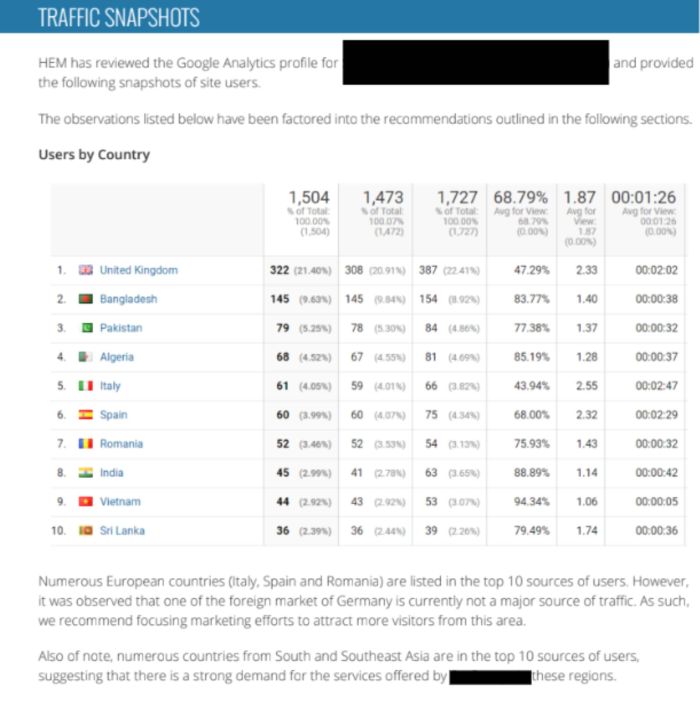

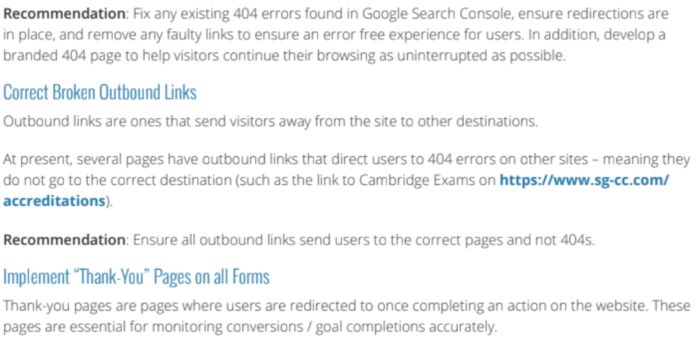

Source: HEM
Example: Digital marketing audits such as the one we completed for one of our clients are an excellent way to reflect on last year’s performance and enter the new year with a data-informed plan. Our digital marketing audits include traffic insights, keyword rankings, and personalized suggestions for optimizing your school site. This provides a solid starting point to creating a marketing plan that drives results.
Do you need support as you create a new digital marketing plan for your school? Reach out to see how our digital marketing services can help.
Reimagine How You Engage with Prospective Students
In 2025, your audience expects you to meet them where they are. To stay relevant, you need to embrace a digital-first strategy that prioritizes engagement over promotion. Emerging technologies like augmented reality (AR) and virtual reality (VR) can bring your campus to life for prospective students, offering immersive experiences that go beyond static images or videos.


Source: University of Western University
Example: This AR campus tour, complete with 360º images, audio guidance, and detailed written descriptions of your campus as Western has done is a convenient, immersive way to share your school with prospects. Take full advantage of new technology when creating an education marketing plan. Though not as revolutionary as AR and VR, social media is another tool you should never neglect when creating a school marketing campaign.
Social media is where the most authentic connections happen, especially on platforms like TikTok and Instagram. But the key to standing out in 2025 will be authenticity. Think about how you can use short-form videos to showcase real student experiences, faculty achievements, or day-in-the-life snapshots. Consider hosting live Q&A sessions or interactive events to foster direct engagement. The more you humanize your institution, the stronger the connection you’ll create with your audience.
Leverage Artificial Intelligence for Smarter Marketing
Artificial intelligence (AI) has moved beyond being a buzzword—it’s now a vital part of successful marketing. This year, take advantage of AI to transform how you interact with prospective students. Predictive analytics, powered by AI, can help you understand student behavior and target your campaigns with unprecedented precision. You can predict the types of students most likely to enroll, what they care about, and how they prefer to engage with your school.
Chatbots are another way AI can streamline your communication. Today’s chatbots don’t just answer basic questions—they guide prospective students through complex processes like application submission or program selection. You can also use AI to personalize your outreach efforts, crafting content tailored to each prospect’s unique interests and behaviors. AI provides efficiency and more; it helps you create an experience that feels relevant and meaningful.
Make Accessibility and Inclusivity a Priority
Your prospective students come from diverse backgrounds and circumstances, and they expect your marketing to reflect that. In 2025, it’s more important than ever to create campaigns that are accessible to everyone. Take a close look at your website and digital content. Is it optimized for screen readers? Does it work seamlessly on mobile devices? These small adjustments can make a big difference in how inclusive your institution feels to prospective students.
Inclusivity also means speaking to the values your audience cares about. Highlighting diversity, equity, and inclusion initiatives on your campus can help students see themselves as part of your community. International students, in particular, will appreciate content that acknowledges their unique needs, whether it’s visa support, language resources, or cultural events. By showing that you’re committed to creating an inclusive environment, you’ll build trust and strengthen your brand.
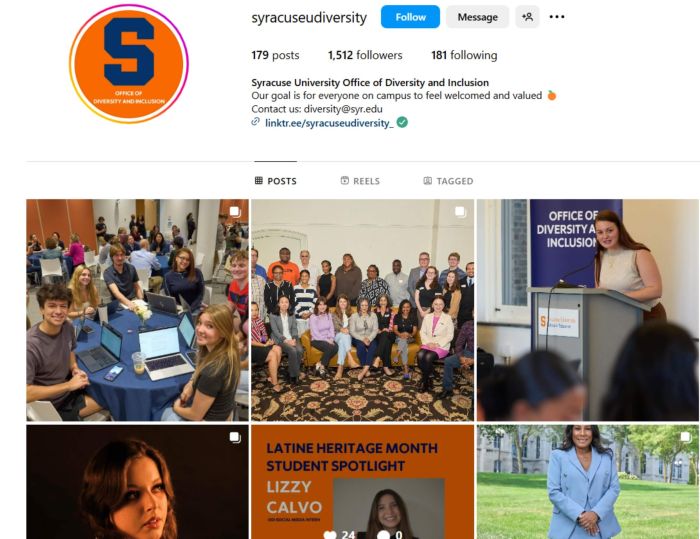

Source: Syracuse University | Instagram
Example: Here, Syracuse University demonstrates its commitment to diversity and inclusion with a dedicated office for championing these principles. On its Instagram page dedicated to its Office of Diversity and Inclusion, Syracuse University provides updates on how it fosters acceptance and respect in meaningful, action-oriented ways.
Adapt Your SEO Strategy for the Future of Search
Search engine optimization (SEO) is evolving, and your strategy needs to keep pace. In 2025, the way people search for information is increasingly conversational. With voice search growing in popularity, you need to focus on optimizing for natural language queries. Prospective students are asking questions like, “What’s the best school for me in New York?” or “How can I study abroad in Italy?” Tailoring your content to match these queries will make it easier for them to find you.
Video SEO is also a critical area to watch. Platforms like YouTube and TikTok are now major search engines for younger audiences. By creating engaging video content and optimizing it with descriptive titles, tags, and captions, you can expand your reach significantly. Don’t forget to prioritize user experience—your website should load quickly, look great on mobile, and provide intuitive navigation.


Source: TikTok
Example: As you create your 2025 SEO strategy, don’t underestimate the importance of video SEO on platforms such as TikTok and YouTube. Your young prospects are searching for information about schools in an easy-to-digest, engaging format. This means that video platforms the perfect place for you to make your first impression on them.
Stay Ahead with Innovative Advertising Strategies
If paid advertising is part of your student recruitment strategy, now is the time to rethink how you’re using it. Interactive ads—featuring live polls, quizzes, or even augmented reality filters—can capture attention and drive engagement. Streaming platforms and connected TV are also gaining traction as advertising spaces, giving you new ways to reach prospective students and their families.
Retargeting campaigns will be even smarter in 2025, thanks to AI. Imagine delivering ads that dynamically adjust based on a prospective student’s previous interactions with your website or social media. These personalized ads feel more relevant, increasing the chances of conversion. At the same time, new privacy regulations mean you’ll need to adopt ethical, transparent practices when handling user data. Building trust with your audience will be just as important as getting their attention.
Use Data to Continuously Improve
Marketing isn’t static—it’s an ongoing process of learning and refining. This year, make data-driven decision-making the backbone of your strategy. Use your analytics tools to track key metrics like website traffic, social media engagement, and lead conversions. What’s working? What’s falling flat? By identifying education marketing trends and adjusting your approach in real time, you can ensure that your efforts are always aligned with your goals.
Predictive analytics can help you go even further by forecasting future trends and identifying areas for growth. For example, if your data shows that a specific program is generating high interest but low conversions, you can adjust your messaging to address potential concerns. The more you rely on insights, the more effective your campaigns will be.
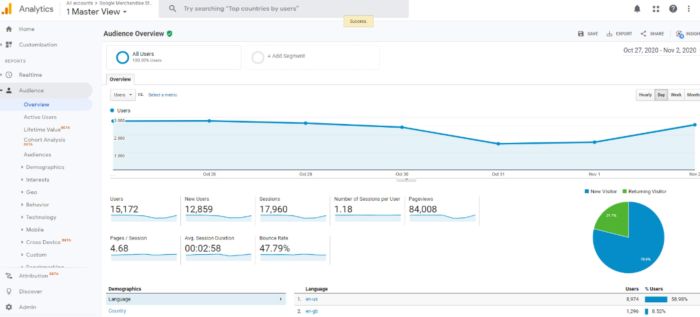

Source: Google Analytics
Example: In 2025, analytics tools will continue to be essential for making informed decisions about your school’s digital marketing strategy. As you can see in the example above, Google Analytics provides information about traffic volume and sources, audience demographics, and user behavior for your site.
Showcase Your Brand’s Values Through Partnerships
Students in 2025 want more than just a degree—they want to join a community that aligns with their values. Highlighting your partnerships with industry leaders, alumni, and global institutions can help reinforce your school’s credibility and reach. Think about how you can collaborate with partners to launch new initiatives, co-host events, or create content that appeals to your target audience.
For international students, partnerships with schools abroad or study-abroad programs can be particularly compelling. Promoting these opportunities shows that you’re forward-thinking and globally minded, which can resonate with students looking for diverse and enriching experiences.
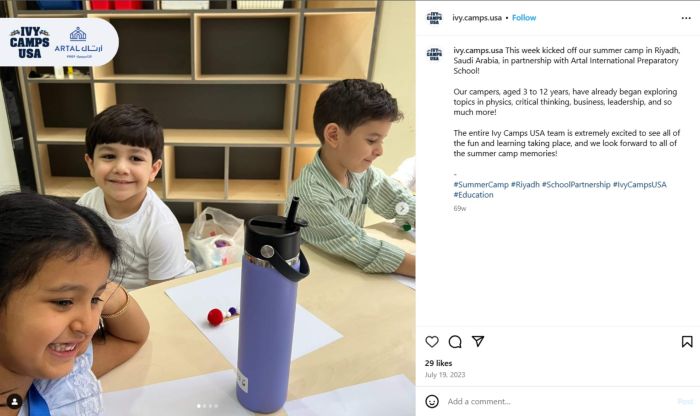

Source: Instagram | Ivy Campus USA
Example: Partnerships are a highly effective way to demonstrate your institution’s commitment to continuous academic enrichment for students. Here, Ivy Campus USA announces a partnership with Artal International Preparatory School that offers young students unique skills. Try forging partnerships that can provide valuable and unique learning opportunities for your prospects.
Anticipate What Students Will Want in 2025
The next generation of students expects your institution to care about issues that affect them directly such as mental health, career development, and sustainability. Incorporating these priorities into your marketing campaigns can help you stand out. Highlight your mental health resources, career placement rates, and green initiatives. Transparency is key—students and their families want clear, honest information about tuition costs, scholarships, and program outcomes.
By anticipating their needs and addressing them upfront, you can create a marketing plan that not only attracts attention but builds trust.
Create a Seamless Multi-Channel Experience
Your audience moves seamlessly between platforms, and they expect your marketing to do the same. Whether someone is exploring your website, scrolling through Instagram, or attending a virtual open house, they should encounter consistent messaging and visuals that reinforce your brand. In 2025, it’s critical to ensure that all your channels work together to provide a unified experience.
Real-time engagement will also be a game-changer. Live events—like virtual Q&A sessions or webinars—offer opportunities to connect directly with prospective students and answer their questions. By creating these interactive moments, you can leave a lasting impression and strengthen their connection to your school.
By embracing new technologies, prioritizing inclusivity, and building campaigns that reflect the values of modern students, you can create a strategy that resonates deeply and drives real results. The new year is your opportunity to reimagine what’s possible, and with the right approach, you’ll not only meet your goals but exceed them.
We’re here to help!
FAQ
What are the 4 stages of the marketing planning process?
Follow these steps: Analyze, plan, implement, and control.
How do you create a marketing plan for education?
Any successful education marketing plan involves a data-driven evaluation of the previous year’s performance, an analysis of current digital marketing trends, and a targeted investigation into what your particular audience needs.



